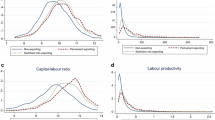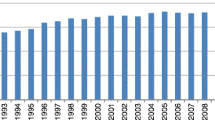Abstract
We test the sunk costs explanation for hysteresis in exports using a sample of Spanish manufacturing firms for the period 1990–2000, allowing for sunk costs to be different for small and large firms. The data are drawn from the Spanish Encuesta sobre Estrategias Empresariales. To obtain consistent estimates for sunk costs, we control for all other sources of persistence and use a dynamic multivariate probit model that is estimated through pseudo simulated maximum likelihood techniques. Our results support the sunk costs explanation for hysteresis for both size groups and indicate that sunk costs are smaller for large firms.
Similar content being viewed by others
References
Baldwin, R. E. (1988). Hysteresis in Import Prices: The Beachhead Effect. American Economic Review 78 (4): 773–785.
Baldwin, R. E. (1989). Sunk Costs Hysteresis. NBER Working Paper 2911. National Bureau of Economic Research, Cambridge, Mass.
Baldwin, R. E., and P. R. Krugman (1989). Persistent Trade Eeffects of Large Exchange Rate Shocks. Quarterly Journal of Economics 104 (4): 635–654.
Baldwin, J. R., and M. Rafiquzzaman (1995). Selection versus Evolutionary Adaptation: Learning and Post-Entry Performance. International Journal of Industrial Organization 13 (4): 501–522.
Bernard, A. B., and J. B. Jensen (1999). Exceptional Exporter Performance: Cause, Effect, or Both? Journal of International Economics 47 (1): 1–25.
Bernard, A. B., and J. B. Jensen (2004). Why Some Firms Export? Review of Economics and Statistics 86 (2): 561–569.
Bernard, A. B., and J. Wagner (1998). Export Entry and Exit by German Firms. NBER Working Paper 6538. National Bureau of Economic Research, Cambridge, Mass.
Campa, J.M. (2004). Exchange Rates and Trade: How Important Is Hysteresis in Trade? European Economic Review 48 (3): 527–548.
Cappellari, L., and S. P. Jenkins (2003). Multivariate Probit Regression Using Simulated Maximum Likelihood. Stata Journal 3 (3): 278–294.
Clerides, S. K., S. Lach, and J. R. Tybout (1998). Is Learning by Exporting Important? Micro-Dynamic Evidence from Colombia, Mexico, and Morocco. Quarterly Journal of Economics 113 (3): 903–947.
Delgado, M. A., J. C. Fariñas, and S. Ruano (2002). Firm Productivity and Export Markets: A Non-Parametric Approach. Journal of International Economics 57 (2): 397–422.
Dixit, A. (1989a). Entry and Exit Decision under Uncertainty. Journal of Political Economy 97 (3): 620–638.
Dixit, A. (1989b). Hysteresis Import Penetration Exchange Rate Pass-Through. Quarterly Journal of Economics 104 (2): 205–228.
Ericson, R., and A. Pakes (1995). Markov-Perfect Industry Dynamics: A Framework for Empirical Work. Review of Economic Studies 62 (1): 53–82.
Gourieroux, C., and A. Monfort (1996). Simulation-Based Econometric Methods. Oxford: Oxford University Press.
Hajivassiliou, V., and P. Ruud (1994). Classical Estimation Methods for LDV Models Using Simulation. In R. Engle and D. McFadden (eds.), Handbook of Econometrics. Amsterdam: North-Holland.
Heckman, J. J. (1981). The Incidental Parameters Problem and the Problem of Initial Conditions in Estimating a Discrete Time–Discrete Data Stochiastic Process. In C. Manski and D. McFadden (eds.), The Structural Analysis of Discrete Data. Cambridge: MIT Press.
Huber, P. J. (1967). The Behavior of Maximum Likelihood Estimators under Non-Standard Conditions. In L. M. LeCam and J. Neyman (eds.), Proceedings of the Fifth Berkeley Symposium in Mathematical Statistics and Probability. Berkeley: University of California Press.
Krugman P. R. (1984). Important Protection as Export Promotion: International Competition in the Presence of Oligopoly and Economies of Scale. In H. Kierzkowski (ed.), Monopolistic Competition and International Trade. Oxford: Oxford University Press.
Krugman P. R. (1989). Exchange-Rate Instability. Cambridge: MIT Press.
Krugman P. R. (1992). Geography and Trade. Cambridge: MIT Press.
Pakes, A., and R. Ericson (1998). Empirical Implications of Alternative Models of Firm Dynamics. Journal of Economic Theory 79 (1): 1–45.
Roberts, M. J., and J. R. Tybout (1997). The Decision to Export in Colombia: An Empirical Model of Entry with Sunk Costs. American Economic Review 87 (4): 545–564.
White, H. (1982). Maximum Likelihood Estimation of Misspecified Models. Econometrica 50 (1): 1–25.
Author information
Authors and Affiliations
Corresponding author
Additional information
JEL no.
F12, L1, C23, C25
About this article
Cite this article
Máñez, J., Rochina-Barrachina, M. & Sanchis, J. Sunk Costs Hysteresis in Spanish Manufacturing Exports. Rev World Econ 144, 272–294 (2008). https://doi.org/10.1007/s10290-008-0147-y
Issue Date:
DOI: https://doi.org/10.1007/s10290-008-0147-y




